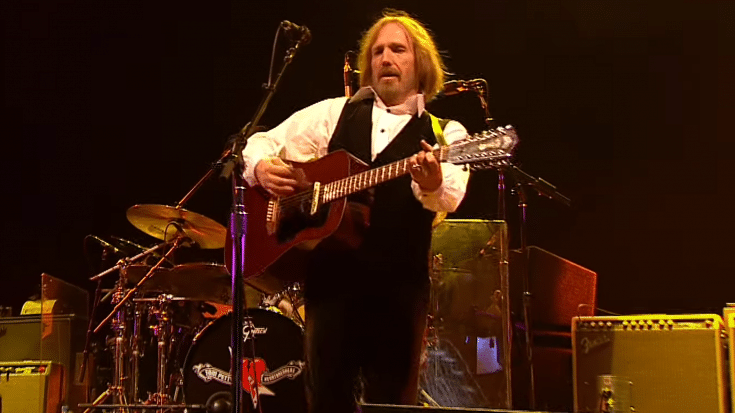Remembering Tom Petty: Legacy of a Music Icon, Six Years After His Passing

via Allyn Kessler / YouTube
Tom Petty’s untimely death in 2017 didn’t come as a shock to him; he had sensed his mortality since 2006. During an interview for his upcoming album, “Highway Companion,” Petty, perched on a stool in his California studio, openly discussed his perspective on life and time. Despite once believing in endless opportunities, age had altered his outlook.
At 55, he recognized life’s brevity, emphasizing the value of time.
Petty, acknowledging his past belief in infinite possibilities, revealed his urgency to accomplish more, given life’s uncertainty. He expressed his desire for a swift exit, rejecting the idea of a prolonged, agonizing demise. Specifically, he stated:
“I want to go out quickly. I don’t want to lie around in a hospital and die slowly.”
He further emphasized:
“Just for the record, I don’t want to die in a plane crash. Really don’t want to do that.”
These quotes reflected Petty’s profound understanding of life’s preciousness and his unwavering determination to live it fully.
Despite the gravity of the conversation, there was a moment of shared laughter.
In a poignant moment on a spring afternoon, Tom Petty contemplated the lasting impact of his artistry. Reflecting on his priorities, he remarked,
“You know, you get concerned with what you leave behind. Artistically, the biggest priority with making records now is that I know this will be here longer than me. Making something that lasts is more important than it being a hit record – although you want them all to be hit records.”
While he decided not to create more solo albums, Petty continued to shape the music scene. He produced two more albums with the Heartbreakers: “Mojo” in 2010 and “Hypnotic Eye” in 2014. He also revisited his roots by re-forming Mudcrutch, his 1970 band. When asked about this revival in 2016, he humorously said:
“I did it because I could.”
It appeared Petty might have been ticking off items from an unspoken bucket list. He supported emerging talents, producing albums for his early hero Chris Hillman of the Byrds and guiding The Shelters, a band connected to his adopted son Dylan. Furthermore, he embarked on a monumental 40th-anniversary tour, despite earlier reservations about long tours. Despite these reservations, he organized a full-scale stadium tour, bringing along fellow artists from the Heartbreakers’ early days and newcomers, including Joe Walsh, Stevie Nicks, Peter Wolf, Chris Stapleton, and The Lumineers. Channeling the spirit of his 1977 performances, he concluded the tour with a spectacular three-day event at the Hollywood Bowl in Los Angeles, just a week before his untimely passing. His dedication to his craft and his audience remained undiminished, leaving an indelible mark on the music industry.
Petty’s focus on making the most of his time translated into his songwriting philosophy.
Tom Petty, renowned for his timeless hits, had a unique approach to songwriting. Despite his indifference towards chasing chart-toppers, his albums like “Highway Companion” and “Hypnotic Eye” claimed top spots on Billboard and Top Rock Albums charts.
Throughout his career, Petty remained remarkably humble, never flaunting his three Grammys or the 80 million records sold. He hosted the top-rated radio show, “Buried Treasure,” on Sirius XM, always exuding a quiet confidence. Petty believed anyone could achieve what he did with dedicated effort.
When inducted into the Songwriters Hall Of Fame alongside music luminaries, he expressed a unique perspective. In a brief speech, he noted the abundance of songs in the world but emphasized his passion for songwriting as a gift, acknowledging the extraordinariness of his craft.
In his words:
“If no one ever wrote another song, we’d be fine, you know? There are plenty of songs. But I still do it because I love it and it’s a gift. It’s not something everybody can do. Well, everybody can do it, but they can’t do it good.”
View this post on Instagram
Petty’s humility was a captivating aspect of his personality.
He found solace in simple things, whether it was falling asleep with the TV on, strolling along the Pacific Ocean, or yearning to fish again. These were the activities that calmed his restless spirit. However, beneath his friendly demeanor was an intricate individual who had little patience for triviality.
Petty’s creativity was a spectrum of colors, each song a different hue and shade. When asked about the color of his album, he replied sharply:
“Each song is a different color and different shades. There would be a lot of silver in it though.”
He detested misinterpretation of his lyrics, despising when people misunderstood his artistic expressions.
Moreover, Petty’s aversion to excessive drinkers stemmed from a life shaped by a tumultuous childhood. Growing up in an abusive environment, music became his refuge, his safe place in a chaotic world. His songs, like “I Won’t Back Down” and “Into The Great Wide Open,” became anthems of resilience, reflecting his unyielding determination to define life on his terms.
“I’m a ridiculous control freak,” he once admitted, acknowledging his struggle for self-mastery.
For Petty, music wasn’t just a career; it was a battleground where he fought for control over himself and his narrative, leaving an enduring legacy not just in sound but in the raw honesty of his humanity.
View this post on Instagram
Petty’s enigmatic nature was evident despite his public image of balance.
In 1961, an 11-year-old Tom Petty stood near Elvis Presley on the set of “Follow That Dream” in Crystal River, Florida. It was a pivotal moment, a brush with greatness that set his life’s course.
“To be truthful, I didn’t really meet Elvis, but I did stand really close to him,” he recalled. “It was everything you thought it would be: this huge ordeal on the street, with hundreds of people and screaming girls and police holding them back… He was about the best-looking thing I’d ever seen. It was so, so cool. After that day, I never thought about much else but rock’n’roll. It certainly changed my life.”
This encounter ignited a spark, a passion for music that led Petty to become one of the greatest rock stars of his generation. The image of that day, with Elvis stepping out of his Cadillac, stayed with him. It fueled his determination and became the foundation of his musical journey.
Despite the fame and success, Petty was far from “normal,” as he confessed. His complexity was evident in the contrast between his onstage confidence and his offstage discomfort. The iconic leather jacket he wore on the cover of his debut album was more than a fashion choice; it was a symbol of defiance, a representation of someone on a mission, just getting started.
His journey began that day in 1961, standing in the presence of a legend. It was a moment that shaped him, propelling him into a world where he would create his own legend, leaving an indelible mark on the history of rock ‘n’ roll.
Petty’s journey into music began with a guitar purchased by his mother and was solidified after watching The Beatles on The Ed Sullivan Show.
He formed Mudcrutch with friends, including Mike Campbell and Benmont Tench, aiming for something bigger. In 1974, a trip to LA led to record deals and their debut album. Tom Petty And The Heartbreakers became authentic mirrors of life’s struggles, reflecting relatable experiences. Petty’s authenticity set them apart, making him a rock star who genuinely understood life’s challenges.
After Shelter Records was sold to MCA in 1978, Petty faced contract disputes and declared bankruptcy in 1979. Despite legal battles, he stood his ground, insisting on fair treatment from record companies. He challenged MCA when they broke their promise to release his album “Hard Promises” at the agreed price, highlighting the industry’s push for higher record prices. Petty continued to assert himself, addressing issues like song use and performing “I Won’t Back Down” as a symbol of solidarity. Throughout four decades, he released 13 albums with the Heartbreakers, three solo albums, and two with the Traveling Wilburys, showcasing his enduring impact on the music industry.
Petty’s ability to connect with legendary musicians like Dylan and Harrison was not something he actively pursued.
In 2006, he remarked,
“I never want to meet anybody, but I always do. I have actually become quite close to them, but it wasn’t because I sought them out. They sought me out for some reason.”
A chance encounter with Jeff Lynne in London led to an unexpected reunion in Los Angeles. Later, when Petty and his daughter decided to dine at a random restaurant, they were surprised to find George Harrison and Jeff Lynne there. Harrison felt a deep connection with Petty, even believing they had shared past lives. Their friendship grew, leading to collaborations on projects like the Traveling Wilburys’ debut album.
Petty’s journey from a landlocked boy in Northern Florida to a renowned musician was driven by his passion for music.
Reflecting on his career, he said,
“I took the road thinking I may not have as nice things as other people are going to have, but I have this and I love to do this.”
He emphasized that he wasn’t just pursuing a career but enjoying playing music and expressing his creativity. Despite struggles, he managed to channel his anger into ambition. Over the years, he learned to cope with the challenges of the business, striving for inner peace amid the chaos. As he stated:
“I still have my moments where I can get really frustrated… But with everything else, I think I’m more at peace. At least I hope I am.”























